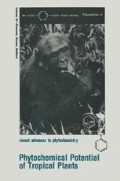Abstract
The last years of the twentieth century offer both challenges and opportunities for phytochemists. The AIDS epidemic is still expanding and to date medical science has not been able to find effective treatments. Resistance to antibiotics, antimalarials, and other drugs occurs with increasing frequency. Crisis like these have created a new demand for phytochemical screening programs to detect antiviral plant products. Consequently the attention of phytochemists has turned to the tropical rain forests that contain most of the world’s species of plants and animals.
Dedicated to the memory of the late Dr. Xorge A. Dominguez.
Access this chapter
Tax calculation will be finalised at checkout
Purchases are for personal use only
Preview
Unable to display preview. Download preview PDF.
References
Janzen, D.H. 1978. Complications in interpreting the chemical defenses of trees against tropical arboreal plant-eating vertebrates. In: The Ecology of Arboreal Folivores. (G.G. Montgomery, ed.). Washington D.C. Smithsonian Institution Press. pp. 73–84.
Clark, L., Mason, J.R. 1985. Use of nest material as insecticidal and antipathogenic agents by the European starling. Oecologia 67:169–176.
Clark, L., Mason, J.R. 1987. Olfactory discrimination of plant volatiles by the European starling. Animal Behavior 35:227–235.
Clark, L., Mason, J.R. 1988. Effect of biolobically active plants used as nest material and the derived benefit to starling nestlings. Oecologica (Berl) 77:174–180.
Clark, L., Smeraski, C.A. 1990. Seasonal shifts in odor acuity by starlings. J. Exp. Zool 255: 22–29
Wrangham, R.W., Nishida, T. 1983. Aspilia spp. leaves: A puzzle in the feeding behaviour of wild chimpanzees. Primates 24:276–282.
Wrangham, R.W., Goodall, J. 1989. Chimpanzee use of medicinal leaves. In: Understanding Chimpanzees. (P.G. Heltne, L.A. Marguart, eds.). Harvard Univ. Press, Cambridge, Massachusetts, pp. 22–37.
Kokwaro, J.O. 1976. Medicinal Plants of East Africa. East Africa Literature Bureau, Nairobi, Kenya.
File, S.K., McGrew, W.C., Tutin, E.G. 1976. The intestinal parasites of a community of feral chimpanzees, Pan troglodytes (Schweinfurthii). J. of Parasitology 62(2):259–26.
Mcgrew, W.C., Tutin, G.E.G., Collins, D.A., File, S.K. 1989. Intestinal parasites of sympatric Pan troglodytes and Papio spp. at two sites; Gombe (Tanzania) and Mt. Assirik (Senegal) Amer. J. Primatol. 17:147–158.
Kawabata, M., Nishida, T. 1991. A preliminary note on the intestinal parasites of wild chimpanzees in the Mahale Mountains, Tanzania. Primates 32(2):275–278.
Reid, G., Wrangham, R.W. 1992. In preparation.
Rodriguez, E., Aregullin, M., Nishida, T., Uehara, S., Wrangham, R.W., Abramowski, Z., Finlayson, A., Towers, G.H.N. 1985. Thiarubrine-A, a bioactive constituent of Aspilia (Asteraceae) consumed by wild chimpanzees. Experientia. 41:419–420.
West, J., Wasser, C., Rodriguez, E. In preparation.
Towers, G.H.N., Abramowski, Z., Finlayson, A.V., Zucconi, A. 1985. Antibiotic properties of thiarubrine A, a naturally occurring dithiahexadiene polyine. Planta Medica 51:225–227.
Pzifer Pharmaceuticals. 1991. Unpublished.
Balza, F., Lopez, I., Rodriguez, E., Towers, G.H.N. 1989. Dithiacyclohexadiene and thiophenes from Ambrosia chamissonis. Phytochemistry 28(12): 3523–3524.
Aregullin, M., Rodriguez, E. In preparation.
Lwande, W., Macfoy, C., Okecj, M., Delle Monache, F., Marini Bettolo, G. 1985. Kaurenoic acids from Aspilia pluriseta. Fitoterapia 65(2): 126–128.
Kapundu, M., Penders, A. 1988. Structure du Kotschyioside, Saponside Novueau Isole de Aspilia kotschyi (Sch. Bip.) Oliv. Bull. Soc. Chim. Belg. Vol. 97(5):329–342.
Hanna, M.M., Niemitz, J. 1987. Studies in anticoagulent action of Aspilia africana. Thrombosis Research 47:401–407.
Akabue, P.I., Mittal, G.C., Aguwa, C.N. 1983. Preliminary Pharmacological study of some African Medicinal Plants. Journal of Ethnopharmacol. 8:53–63.
Page, J., Towers, G.H.N. 1992. Personal Communication.
Nishida, T. 1990. A quarter century of research in the Mahale Mountains: an overview. In: The Chimpanzees of the Mahale Mountains: Sexual and Life History Strategies. (T. Nishida, ed.). University of Tokyo Press, Tokyo, pp. 3–35.
Barrera, E., Rodriguez, E. 1990. Studies on the African plant Ficus exasperala eaten by wild chimpanzees Pan troglodytes, (Schweinfurthii). Society for the Advancement of Chicanos and Native Americans in Science (SACNAS) Phoenix, Arizona.
Itokawa, H., Takeya, K. Mihara, K., Mori, N., Hamanaka, T., Sonobe, T., Iitoka, Y. 1983. Studies on the antitumor cyclic hexapeptides, obtained from Rubia radix. Chemical and Pharmcology Bulletin 37(6): 1670–1672.
Huffman, M.A., Seifu, M. 1989. Observations on the illness and consumption of a possibly medicinal plant Venonia amygdalina (Del.) by a wild chimpanzee in the Mahale Mountains National Park, Tanzania. Primates 30(1):51–63.
Jisaka, M., Ohigashi, H., Takagaki, T., Nozaki, H., Tada, T., Hirota, M. I., Rie, R., Huffman, M.A., Nishida, T., Kaji, M., Koshimizu, K. 1992. Bitter steroid glucosides, vernoniosides, A., A2 and A3 and Related B1 from a possible medicinal plant, Vernonia amygdalina, used by wild chimpanzees. Tetrahedron 48(4):625–532.
Kupchan, S.M., Hemingway, R.J., Karim, A., Werner, D. 1969. Tumor Inhibitors. XLVII Vernodalin and vernomygdin, two new cytotoxic sesquiterpene lactones from Vernonia amygdalina. J. Org. Chemistry 34(2):3908–3911.
Takasaki, H., Hunt, K. 1987. Further medicinal plant consumption in wild chimpanzees. Afr. Study Monographs 8(2): 125–128.
Tutin, C. 1992. Personal Communication.
Huffman, M. 1992. Personal Communication.
Simmons, Kel. 1964. Feather maintenance. In: A New Dictionary of Birds. (Sir A. Landsborough-Thomson, ed.). New York. McGraw-Hill, pp. 278–286.
Mitchell, B. 1989. PH.D. Dissertation. University of California, Berkeley.
Sigstedt, S. 1992. Personal Communication.
Gompper, M.E., Hoylman, A.M. 1992. Grooming with Trattinnickia resin: Possible pharmaceutical plant used by coatis in Panama (In preparation).
Perry, S. 1992. Unpublished field observations.
Author information
Authors and Affiliations
Editor information
Editors and Affiliations
Rights and permissions
Copyright information
© 1993 Springer Science+Business Media New York
About this chapter
Cite this chapter
Rodriguez, E., Wrangham, R. (1993). Zoopharmacognosy: The Use of Medicinal Plants by Animals. In: Downum, K.R., Romeo, J.T., Stafford, H.A. (eds) Phytochemical Potential of Tropical Plants. Recent Advances in Phytochemistry, vol 27. Springer, Boston, MA. https://doi.org/10.1007/978-1-4899-1783-6_4
Download citation
DOI: https://doi.org/10.1007/978-1-4899-1783-6_4
Publisher Name: Springer, Boston, MA
Print ISBN: 978-1-4899-1785-0
Online ISBN: 978-1-4899-1783-6
eBook Packages: Springer Book Archive

